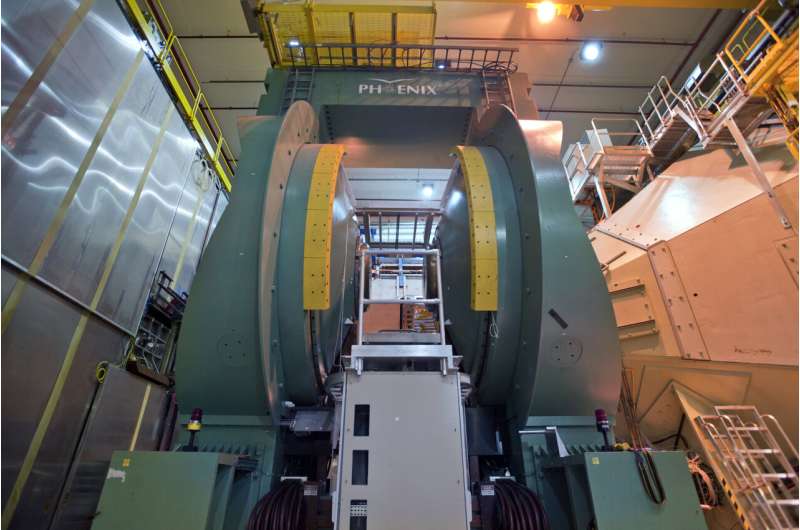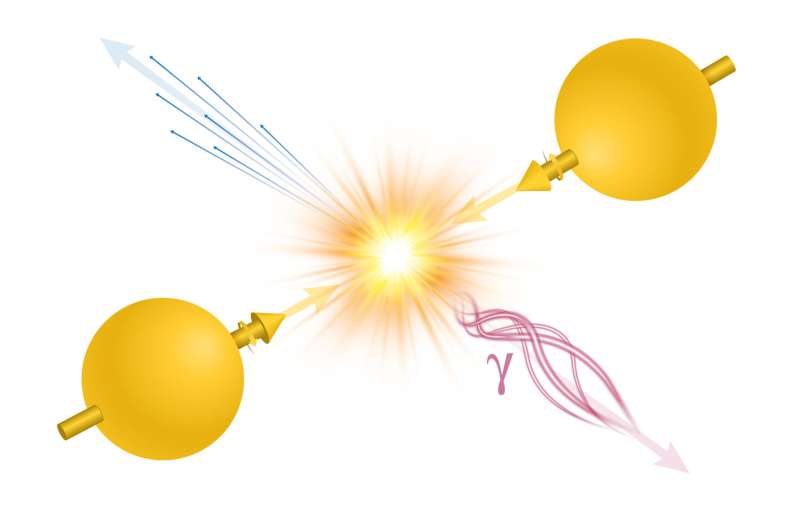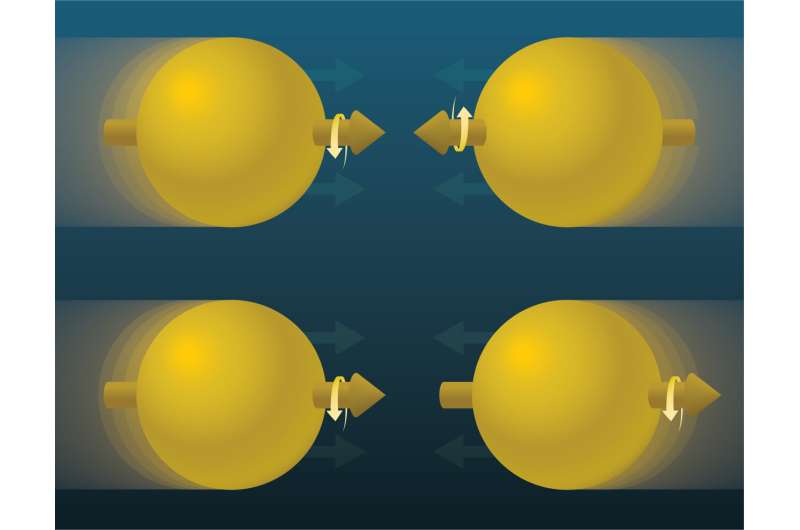This article has been reviewed according to Science X's editorial process and policies. Editors have highlighted the following attributes while ensuring the content's credibility:
fact-checked
peer-reviewed publication
trusted source
proofread
Direct photons point to positive gluon polarization

A new publication by the PHENIX Collaboration at the Relativistic Heavy Ion Collider (RHIC) provides definitive evidence that gluon "spins" are aligned in the same direction as the spin of the proton they're in. The result, just published in Physical Review Letters, provides theorists with new input for calculating how much gluons—the gluelike particles that hold quarks together within protons and neutrons—contribute to a proton's spin.
Whether and how much gluons contribute to proton spin—an intrinsic angular momentum that's associated with the protons' optical, magnetic, and other properties—has been an open question since 1987. That's when an experiment at Europe's CERN laboratory revealed that quarks, the other components of protons and neutrons, cannot account for a proton's total spin value.
"I was involved in the CERN experiment that established that quarks didn't carry too much of the spin. That was a big surprise; it ignited a 'spin crisis,'" said Abhay Deshpande, a physicist at Stony Brook University (SBU) and the U.S. Department of Energy's (DOE) Brookhaven National Laboratory, where RHIC operates as a DOE Office of Science user facility for nuclear physicists from all over the world. "Obviously, the remaining spin had to come from somewhere else. So, at the time, there were ideas that gluons might carry the rest of the spin."
The search for answers turned to Brookhaven Lab, where RHIC was taking shape to explore a different set of physics questions related to the way quarks and gluons existed in the early universe. But the spin mystery attracted a whole new set of collaborators—and significant contributions from Japan's RIKEN laboratory—to expand RHIC's capabilities. These included specialized accelerator components that allow RHIC to align and "flip" the spins of protons (making it the only polarized proton collider in the world), and additional equipment for making key spin measurements at the PHENIX experiment, one of RHIC's first particle detectors.
"At the beginning of the RHIC project, we felt this is the place we must go," said Hideto En'yo, a RIKEN physicist and one of the spokespersons of the first proposal for polarized proton acceleration at RHIC. "We were so excited when we realized that RHIC is polarizable, which enables us to resolve gluons' role in the proton spin crisis."
Brookhaven Lab accepted the proposal for the accelerator and detector additions, and RIKEN provided funding.
"In addition, because this was more than just participating in one experiment, RIKEN decided to establish the RIKEN-BNL Research Center (RBRC) to be RIKEN's forward base and home at Brookhaven Lab for the experimentalists and theorists needed to pursue these questions," En'yo said.
Golden measurement
The new PHENIX result is one of the "golden" measurements proposed as a key motivator for the RHIC spin physics program. It's a comparison of the number of "direct photons" (particles of light) emitted when RHIC collides protons with their spins pointing in opposite directions (either at or away from each other) with the number of direct photons produced when the protons in the two beams are pointing in the same direction (colliding head to tail).
For reasons having to do with the way quarks and gluons can interact to emit photons (and knowing that net quark spins are positively aligned with proton spin), seeing a difference would indicate that gluon spins are also aligned, or polarized—and, importantly, in which direction. That is, the collision condition producing more direct photons would tell them whether the gluon spin alignment was positive—pointing in the same direction as the proton spin and contributing to that value—or negative (pointing in the opposite direction and counteracting the quarks' contributions to spin).
"This is a very clean and simple result for interpretation," said Brookhaven Lab physicist Alexander (Sasha) Bazilevsky, deputy spokesperson for the PHENIX Collaboration. "The beauty of the direct photons is that their production at RHIC is dominated by quark-gluon interactions," he said. In other words, these particles of light come directly from the interaction of a quark in one proton beam with a gluon in the other—rather than from the decay of some other particle produced in the collision.
"And, when a photon is created, because it doesn't carry any color charge [the form of charge that drives strong-force interactions among quarks and gluons] it doesn't interact with the surrounding nuclear matter," Deshpande said. "That's what makes it such a clean measurement."
But despite that apparent simplicity, "it's pretty hard to measure experimentally," Bazilevsky said.

The numbers game
One reason for the difficulty is that lots of other photons stream out of RHIC collisions. Finding those that come directly from quark-gluon interactions requires a systematic process of elimination.
"No other experiment or detector could do this measurement," said Yasuyuki Akiba, a physicist at the RIKEN Nishina Center for Accelerator-Based Science, spokesperson for the PHENIX Collaboration, and Experiment Group Leader at the RBRC. "But because PHENIX had the most finely grained electromagnetic calorimeter (EMCal) ever built for a collider experiment, it provided the capabilities needed to separate out direct photons from those coming from other sources," he explained.
For example, if a photon picked up in the detector is surrounded by other particles, it likely came from radiative processes that happened after the collision—so those photons are not direct. Likewise, if the energy and angles of a pair of photons can be reconstructed to have originated from the decay of a parent particle—a pi zero meson, say—then those photons are also not direct photons. After all the eliminations, the photons with no other obvious source are assumed to have originated from a quark-gluon scattering event.
To be left with enough direct photons for a proper statistical analysis after filtering out other photon-producing processes, the scientists also needed a very high number of collisions, or luminosity. When RHIC first started colliding polarized protons in the early 2000s, it didn't have the numbers.
"Robert Bennett (now a data scientist in Washington, DC) was the first of my students to start working on this in the late 2000s, using analysis methods originally developed by Kensuke Okada of the RBRC and RIKEN," Deshpande said. "The method worked, and we got preliminary results, but we didn't have enough statistics to have a publication."
Meanwhile PHENIX and STAR, RHIC's other large detector, made other measurements related to gluon spin. STAR's analysis of particle jets and PHENIX's analysis of pi zero mesons showed that gluons were indeed polarized. "It was a big discovery," Bazilevsky said.
But those measurements couldn't reliably reveal the direction of the gluons' spin alignment—whether it was along the direction of proton polarization or against it. In addition, because the particles tracked in those measurements do interact via the exchange of color charges, their signals were not as clean as the expected direct photon measurements.
Fortunately, the communities of experimental and accelerator physicists who were seeking to push RHIC to ever-higher levels of performance persevered.
"Many scientists—including those at RIKEN, the RBRC, and local Brookhaven Lab physicists Gerry Bunce of the Physics Department and Yousef Makdisi of C-AD—helped to push the program forward," Deshpande said. "Sasha and I came in as young scientists/RBRC fellows, and they were the seniors who were mentoring us in every way."
"And Thomas Roser [an accelerator physicist who later became Collider-Accelerator Department (C-AD) chair] was a big promoter of the spin program," he added. "He understood how difficult it was. But he also understood that the challenge was exciting, and that new scientists would come here to take on the challenge—and that their efforts would improve the collider for the entire RHIC program."
The investment paid off. By 2013, RHIC's luminosity for both polarized proton and heavy ion collisions far exceeded the limits of its initial design. And innovative advances in accelerator physics had pushed the degree of polarization in the proton beams to nearly 60%.
Dedicated student(s) and experience
One more ingredient was still needed: a student willing to take on the complex analysis.
"When the luminosity and polarization of RHIC were coming up, it was to the credit of Zhongling Ji, who joined my group as a Stony Brook University graduate student in 2015 and understood how difficult this problem was, that he still jumped in and stuck with it," Deshpande said.
The analysis progressed over Zhongling's graduate career, extended a bit longer than a typical Ph.D. student's work by the delays imposed by the COVID-19 pandemic.
"As noted, one of the major obstacles in this analysis is effectively removing the considerable background of photons that come from the decay of other particles produced in RHIC's collisions," said Ji, now a postdoctoral scholar at UCLA. "Our analysis built on the work of Okada and Bennett, as well as the contributions of Sasha and Sanghwa Park while she was a postdoc at Stony Brook (now a physicist at Thomas Jefferson National Accelerator Facility). They were heavily involved in the analysis. Where reconstructing photons resulting from the decay of other particles was not feasible, we instead relied on dedicated simulations to determine the frequency of these occurrences and carefully remove them from the data. That allowed us to zero in on a high enough number of direct photons to perform a statistically valid analysis."

The results published in PRL are based on data collected in 2013, the last year high-energy longitudinally polarized protons were run while RHIC's PHENIX detector was still collecting data. (PHENIX shut down in 2016 to make way for sPHENIX, RHIC's brand new detector.) The data analyzed corresponds to about 5.4 trillion proton-proton collisions.
"In the end, it took five students over 15 years to complete this analysis," said Deshpande, praising Zhongling's dedication but also acknowledging the experience gained through those earlier efforts. "Everything all these students did was building toward this. It was all important work."
The findings and the future
The PHENIX results show a clear difference in direct photon yields, with higher yields coming from the collisions where the proton spins are pointing in opposite directions (at or away from one another). This is clear evidence that the gluon spins are aligned in the same direction as the proton spin and make a significant contribution to the proton's overall spin value. The new analysis will now provide input for theorists' calculations to determine just how much of a contribution that is.
Does that finally solve the proton spin mystery? Not quite, the scientists say.
The final contribution to proton spin is likely the orbital motion of quarks and gluons within these composite particles. Those details are inaccessible in collisions of longitudinally polarized protons.
Collisions at RHIC where protons are collided with their spins pointing "up," or transversely, have shown hints of the gluons' orbital motion. But precision measurements of orbital motion will have to wait for the opening of the Electron-Ion Collider, a new facility for nuclear physics research that will be built by repurposing much of RHIC's infrastructure.
The EIC will use polarized electron-proton collisions to measure the spin contribution of gluons with higher precision. These EIC experiments will improve significantly on the measurements that have been possible at RHIC in a complementary way. Furthermore, while RHIC gave excellent access to the highest "momentum fraction" gluons (those carrying a large fraction of the overall proton momentum), the EIC will give scientists access to low momentum fraction gluons. While these "low x" gluons each carry a small fraction of the overall proton momentum, they may make an outsized contribution to proton spin due to their relative abundance.
Bazilevsky noted how the EIC will bring the spin mystery full circle: "The spin crisis started with deep inelastic scattering experiments at CERN in collisions of muons (cousins of electrons) on protons, which showed the quarks alone can't account for spin. Then RHIC's proton-proton experiments have revealed a lot about gluons. Now we will go back to electron-proton collisions at the EIC, with higher collision rates and both beams polarized, to finally solve this puzzle."
More information: Measurement of direct-photon cross section and double-helicity asymmetry at √ s = 510 GeV in → p + → p collisions, Physical Review Letters (2023). journals.aps.org/prl/abstract/ … ysRevLett.130.251901
Journal information: Physical Review Letters
Provided by Brookhaven National Laboratory




















